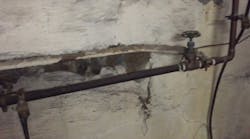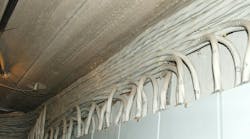The Good vs. The Bad
First, the good. The common grounding electrode conductor (GEC) and the grounding electrode tap conductors in these raceways are for grounding of several transformers in this electrical room, as permitted by Sec. 250.30(A)(6). Making connections from the GEC taps to the common GEC via copper bus bars is permitted as specified in Sec. 250.30(A)(6)(c). Listed connections must be used for this application. The common GEC must be a minimum size — 3/0 copper in accordance with Sec. 250.30(A)(6)(a)(1). The GEC taps are sized using Table 250.66 based on the size of the derived ungrounded conductors. Now it’s time for the bad. The tiny bonding jumper used for bonding the metal raceways to the conductors contained inside of the raceways is way too small. Section 250.64(E)(3) requires the bonding jumper for a metal raceway enclosing a GEC to be the same size or larger than the enclosed conductor. The present wording in the Code does not specifically address sizing of the bonding jumper for a raceway containing more than one GEC. However, it looks like a change in the 2020 Code will address such installations.
Better Call the Terminator to Fix this Mess
It’s always frustrating and scary when I find stuff like this hidden above a suspended ceiling. Who would think this was a good idea? This unsecured but energized MC cable was just thrown up on top of some pipes above the ceiling. Leaving energized conductors exposed like this can be a very dangerous practice. An unsuspecting worker could easily grab this cable, thinking it was abandoned or de-energized. That could end up being a deadly mistake. While there is no Code rule requiring all abandoned wiring to be removed, there is a requirement in Sec. 300.15 that requires a box or conduit body to be installed where conductors are terminated in Chapter 3 wiring methods such as this MC cable. Installing the end of this MC cable into a box that has a cover and is properly secured in accordance with any of the provisions of Sec. 314.23 would go a long way toward making this a much safer installation. There are provisions for temporary power installations in Sec. 590.4(G) that allow splices to be made on construction sites without the use of a box. However, this photo was taken at an occupied building — not at a construction site.






